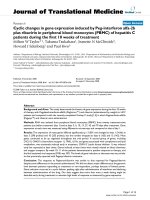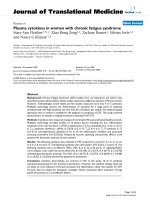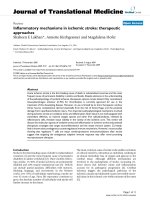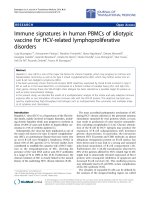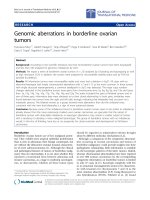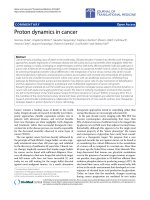Báo cáo hóa học: " Proton dynamics in cancer" pdf
Bạn đang xem bản rút gọn của tài liệu. Xem và tải ngay bản đầy đủ của tài liệu tại đây (412.8 KB, 4 trang )
Huber et al. Journal of Translational Medicine 2010, 8:57
/>Open Access
COMMENTARY
© 2010 Huber et al; licensee BioMed Central Ltd. This is an Open Access article distributed under the terms of the Creative Commons
Attribution License ( which permits unrestricted use, distribution, and reproduction in
any medium, provided the original work is properly cited.
Commentary
Proton dynamics in cancer
Veronica Huber
1
, Angelo De Milito
2,9
, Salvador Harguindey
3
, Stephan J Reshkin
4
, Miriam L Wahl
5
, Cyril Rauch
6
,
Antonio Chiesi
2
, Jacques Pouysségur
7
, Robert A Gatenby
8
, Licia Rivoltini
1
and Stefano Fais*
2
Abstract
Cancer remains a leading cause of death in the world today. Despite decades of research to identify novel therapeutic
approaches, durable regressions of metastatic disease are still scanty and survival benefits often negligible. While the
current strategy is mostly converging on target-therapies aimed at selectively affecting altered molecular pathways in
tumor cells, evidences are in parallel pointing to cell metabolism as a potential Achilles' heel of cancer, to be disrupted
for achieving therapeutic benefit. Critical differences in the metabolism of tumor versus normal cells, which include
abnormal glycolysis, high lactic acid production, protons accumulation and reversed intra-extracellular pH gradients,
make tumor site a hostile microenvironment where only cancer cells can proliferate and survive. Inhibiting these
pathways by blocking proton pumps and transporters may deprive cancer cells of a key mechanism of detoxification
and thus represent a novel strategy for a pleiotropic and multifaceted suppression of cancer cell growth.
Research groups scattered all over the world have recently started to investigate various aspects of proton dynamics in
cancer cells with quite encouraging preliminary results. The intent of unifying investigators involved in this research
line led to the formation of the "International Society for Proton Dynamics in Cancer" (ISPDC) in January 2010. This is
the manifesto of the newly formed society where both basic and clinical investigators are called to foster translational
research and stimulate interdisciplinary collaboration for the development of more specific and less toxic therapeutic
strategies based on proton dynamics in tumor cell biology.
Cancer remains a leading cause of death in the world
today. Despite decades of research to identify novel thera-
peutic approaches, durable regressions remain rare in
patients with advanced disease, and survival benefits
from new therapies are often negligible. Early diagnosis
and treatment, rather than successful therapeutic inter-
vention late in the disease process, are mostly responsible
for the decreased mortality observed in some types of
cancer (WHO).
The war against cancer has been heavily influenced by
the principle of Paul Ehrlich's 'magic bullet', an idea origi-
nally introduced more than 100 years ago, and validated
by the discovery of antibiotics 50 years later. Clinical can-
cer therapy implicitly assumes that similar magic bullets
for cancer can be found with sufficient diligence. How-
ever, all attempts to find new drugs that selectively target
and kill tumor cells have not been successful [1] and
today we are still waiting for the magic bullet directed
against most malignant tumors. As a result, alternative
therapeutic approaches aimed at controlling rather than
curing this disease are increasingly advocated [2].
In the past decade cancer imaging with FdG PET has
become commonplace demonstrating that more than
90% of clinical cancers of sufficient size to be imaged take
up glucose several fold more than adjacent normal tissue.
Remarkably, although this appears to be the single most
common property of the "tumor phenotype" the causes
and consequences of glycolysis have rarely been consid-
ered as a therapeutic target. We propose that a new
approach towards the war against cancer can be found in
re-considering the critical differences in the metabolism
of a tumor cell as compared to a normal one. More than
80 years ago the Nobel Prize winner Otto Heinrich War-
burg discovered that tumors use glycolytic metabolism
even in the presence of normal oxygen tension, an appar-
ent paradox, since glycolysis is 18-fold less efficient than
oxidative phosphorylation in producing energy (ATP). He
also found that cancer cells were, unlike normal cells, able
to live in the acidic environment that developed as a con-
sequence of elevated lactic acid production by glycolysis.
Today, we know that the metabolic changes occurring
during cancer progression are mediated by two major
* Correspondence:
2
Department of Therapeutic Research and Medicines Evaluation, Unit of
Antitumor Drugs, Istituto Superiore di Sanità, Rome, Italy
Full list of author information is available at the end of the article
Huber et al. Journal of Translational Medicine 2010, 8:57
/>Page 2 of 4
pathways, i.e. the activity of hypoxia-inducible factor 1
(HIF-1) and oncogene activation [3,4]. The selective abil-
ity of tumor cells to adapt their metabolism to a hostile
microenvironment is revealing new therapeutic targets to
selectively eliminate cancer cells [5,6].
We propose that the development of new anti-cancer
therapies should include a focus on understanding both
abnormal glucose metabolism and mechanisms used by
cancer cells to survive and proliferate in the hostile
microenvironment. In the latter, a dominant role is
played by protons accumulating at the tumor site as a
result of highly proliferating cancer cells relying on glyco-
lysis with high lactic acid production and limited removal
due to poor perfusion. To avoid acidification of intracel-
lular pH, glycolytically-produced acid must be extruded
by tumor cells through a number of proton transporters,
such as V-ATPase [7], the Na
+
/H
+
exchanger (NHE) [8],
the carbonic anhydrases [9], the proton linked monocar-
boxylate transporter MCTs [4], the Cl
-
/HCO3
-
exchang-
ers and ATP synthase [10]. The increased activity of these
transporters cause reversal of the normal intra-extracel-
lular pH gradients, so that cancer cells produce signifi-
cant acidification of the extracellular microenvironment,
while they maintain a normal or slightly alkaline pH.
In contrast to cancer cells, the acidic extracellular space
reduces viability and function of most normal cells
including cytotoxic T cells that ordinarily mediate the
immune response to tumor antigens. As a result, the
tumor site becomes a relative sanctuary in which immune
cells and other host cellular components are significantly
inhibited. Interestingly, the acidic pH of tumor microen-
vironment also appears to favor the recruitment of
immunosuppressive cells, such as myeloid-derived sup-
pressor cells, further promoting escape from immune
surveillance, neo-angiogenesis and stromal remodeling
[11]. In addition, there is evidence that an acidic extracel-
lular pH promotes invasiveness and metastatic behavior
in several tumor models [12,13], through a number of
mechanisms such as increased traffic of acidic vesicles
[14] and increased release of exosomes [15], whose pro-
tumorigenic features are clearly emerging [16,17], lytic
enzyme activation and matrix destruction [12,18] as well
as aberrant phagocytic activity [19].
Clearly, these complex interactions of tumor and
microenvironment represent a dynamic non-linear sys-
tem and, as a result, a number of multidisciplinary groups
at the interface between scientific fields, i.e. physics,
mathematics and biology, are attempting to provide a
unified frame to address these changes theoretically and
experimentally [20-22]. Understanding the interactions of
the physical microenvironment and cellular properties
will be required to exploit the tumor metabolism as a
therapeutic strategy.
One emerging theme from this work is that the detoxi-
fication mechanisms that allow cancer cells to survive in
extremely hostile conditions represent very appealing
therapeutic targets. Thus, inhibition of membrane-bound
carbonic anhydrases, proton pumps and transporters,
which appear to be major pathways used by tumor cells to
export protons [23-30], may represent a novel and prom-
ising target for exerting a pleiotropic, multifaceted sup-
pression of cancer cell growth and progression. Several
lines of evidence suggest that the majority of human can-
cers may potentially be responsive to therapies based on
inhibition of mechanisms underlying tumor acidification
[25-27].
Indeed, recent research has supported the idea that
inhibiting tumor proton pumps and transporters may
deprive cancer cells of a key mechanism of detoxification
[7,22,23]. During the last decade, this H
+
- related
approach mainly focused on the dynamics of protons in
cancer has integrated many basic and clinical aspects, as
well as several areas of cancer research and treatment,
under a unified perspective and paradigm in modern
translational oncology [31]. However, to date proton
pump inhibition as an antitumor strategy has remained
neglected in the clinic, despite mounting evidence of its
potential use as an inexpensive and relatively non-toxic
treatment. For example, a class of proton pump inhibitors
currently used to treat peptic ulcers has now entered clin-
ical trials for treatment of patients affected by melanoma
and osteosarcoma with the endpoints of evaluating the
chemosensitization effect of pre-treatment with high
dosages of esomeprazole.
Several research groups scattered all over the world
have recently started to investigate various aspects of
proton dynamics in cancer cells, with quite encouraging
preliminary results. With the intent of unifying investiga-
tors involved in this line of research the First Interna-
tional Symposium entitled "Proton transport and its
inhibition (PTI) in the etiopathogenesis, diagnosis and
treatment of cancer" was held in Madrid, Spain, in April
2009. At this meeting we explored the main aspects of
proton dynamics and the potential involvement in cancer
etiology, etiopathogenesis and treatment. The main goals
of this International Symposium were: a) To lead towards
a unified and integrated understanding of the main role
of H
+
dynamics in modern cancer research; b) To discuss
the more recent scientific data of intra and extracellular
pH abnormalities in the onset of cancer as well as in its
local and metastatic progression, focusing mainly on the
molecular mechanisms driving the alterations of pH in
various tumor types and tissues; c) To shed light on new
potential targets for inducing selective apoptosis and
other therapeutic interventions in malignant tumors and
leukemias resistant to traditional treatments.
Huber et al. Journal of Translational Medicine 2010, 8:57
/>Page 3 of 4
Both basic researchers and clinical oncologists partici-
pating at this meeting thought it was time to create a
Society to attract the attention of lay people and the rest
of the scientific community with respect to the emerging
importance of acidity and proton dynamics in cancer
pathogenesis and treatment. An intensive crosstalk
between meeting attendees led to the formation of the
"International Society for Proton Dynamics in Cancer"
(ISPDC) in January 2010. This society is composed of
researchers from all over the world who share the convic-
tion that targeting tumor acidic pH could represent a sig-
nificant advance in the treatment of most solid malignant
tumors. Decreasing proton production, blocking proton
extrusion, or increasing extracellular pH could result in a
selective strategy to increase tumor cell death and/or to
reduce proliferation and invasion.
The newly formed "International Society for Proton
Dynamics in Cancer", focusing on the aspects of pH and/
or dynamics of protons in cancer, will meet again during
its First International Meeting in Rome on September
27th-28th 2010
. Both basic researchers
and clinical oncologists are called upon to participate in
this meeting where we hope to create an ideal environ-
ment to discuss several aspects of these new therapeutic
approaches and develop implementation plans. The aim
of the meeting is to foster translational research and stim-
ulate interdisciplinary collaboration for developing new
treatment targets and more specific and less toxic thera-
peutic strategies based on the most recent knowledge on
proton dynamics in tumor cell biology.
Competing interests
The authors declare that they have no competing interests.
Authors' contributions
All authors gave intellectual contributions and participated in writing the man-
uscript. All authors read and approved the final manuscript.
Author Details
1
Unit of Immunotherapy of Human Tumors, Fondazione IRCCS Istituto
Nazionale Tumori, Milan, Italy,
2
Department of Therapeutic Research and
Medicines Evaluation, Unit of Antitumor Drugs, Istituto Superiore di Sanità,
Rome, Italy,
3
Institute for Clinical Biology and Metabolism, Vitoria, Spain,
4
Department of General and Environmental Physiology, University of Bari, Bari,
Italy,
5
Department of Cell Biology, Johns Hopkins, Baltimore, MD, USA,
6
School
of Veterinary Medicine & Science, University of Nottingham, College Road,
Sutton Bonington, LE12 5RD, UK,
7
Institute of Developmental Biology & Cancer,
CNRS, Centre A. Lacassagne, University of Nice, France,
8
Department of
Radiology and Integrative Mathematical Oncology, Moffitt Cancer Center,
Tampa, FL, USA and
9
Cancer Center Karolinska, Karolinska Institute, Stockholm,
Sweden
References
1. Nygren P, Larsson R: Overview of the clinical efficacy of investigational
anticancer drugs. J Intern Med 2003, 253:46-75.
2. Gatenby RA: A change of strategy in the war on cancer. Nature 2009,
459:508-509.
3. Hsu PP, Sabatini DM: Cancer cell metabolism: Warburg and beyond. Cell
2008, 134:703-707.
4. Pouyssegur J, Dayan F, Mazure N: Hypoxia signaling in cancer and
approaches to enforce tumor regression. Nature 2006, 441:437-443.
5. Jin S, DiPaola RS, Mathew R, White E: Metabolic catastrophe as a means
to cancer cell death. J Cell Sci 2007, 120:379-383.
6. Tennant DA, Duran RV, Gottlieb E: Targeting metabolic transformation
for cancer therapy. Nat Rev Cancer 2010, 10:267-277.
7. Fais S, De Milito A, You H, Qin W: Targeting vacuolar H
+
-ATPases as a new
strategy against cancer. Cancer Res 2007, 67:10627-10630.
8. Cardone RA, Casavola V, Reshkin SJ: The role of disturbed pH dynamics
and the Na
+
/H
+
exchanger in metastasis. Nat Rev Cancer 2005,
5:786-795.
9. Supuran CT: Carbonic anhydrases: novel therapeutic applications for
inhibitors and activators. Nat Rev Drug Discov 2008, 7:168-181.
10. Kenan DJ, Wahl ML: Ectopic localization of mitochondrial ATP synthase:
a target for anti-angiogenesis intervention? J Bioenerg Biomembr 2005,
37:461-465.
11. Gabrilovich DI, Nagaraj S: Myeloid-derived suppressor cells as regulators
of the immune system. Nat Rev Immunol 2009, 9:162-174.
12. Martinez-Zaguilan R, Seftor EA, Seftor RE, Chu YW, Gillies RJ, Hendrix MJ:
Acidic pH enhances the invasive behavior of human melanoma cells.
Clin Exp Metastasis 1996, 14:176-186.
13. Gatenby RA, Gillies RJ: A microenvironmental model of carcinogenesis.
Nat Rev Cancer 2008, 8:56-61.
14. Raghunand N, Martinez-Zaguilan R, Wright SH, Gillies RJ: pH and drug
resistance. II. Turnover of acidic vesicles and resistance to weakly basic
chemotherapeutic drugs. Biochem Pharmacol 1999, 57:1047-1058.
15. Parolini I, Federici C, Raggi C, Lugini L, Palleschi S, De Milito A, Coscia C,
Iessi E, Logozzi M, Molinari A, Colone M, Tatti M, Sargiacomo M, Fais S:
Microenvironmental pH is a key factor for exosome traffic in tumor
cells. J Biol Chem 2009, 284:34211-34222.
16. Iero M, Valenti R, Huber V, Filipazzi P, Parmiani G, Fais S, Rivoltini L:
Tumour-released exosomes and their implications in cancer immunity.
Cell Death Differ 2008, 15:80-88.
17. Al-Nedawi K, Meehan B, Rak J: Microvesicles: messengers and mediators
of tumor progression. Cell Cycle 2009, 8:2014-2018.
18. Lu X, Qin W, Li J, Tan N, Pan D, Zhang H, Xie L, Yao G, Shu H, Yao M, Wan D,
Gu J, Yang S: The growth and metastasis of human hepatocellular
carcinoma xenografts are inhibited by small interfering RNA targeting
to the subunit ATP6L of proton pump. Cancer Res 2005, 65:6843-6849.
19. Lugini L, Matarrese P, Tinari A, Lozupone F, Federici C, Iessi E, Gentile M,
Luciani F, Parmiani G, Rivoltini L, Malorni W, Fais S: Cannibalism of live
lymphocytes by human metastatic but not primary melanoma cells.
Cancer Res 2006, 66:3629-3638.
20. Rauch C: Toward a mechanical control of drug delivery. On the
relationship between Lipinski's 2nd rule and cytosolic pH changes in
doxorubicin resistance levels in cancer cells: a comparison to
published data. Eur Biophys J 2009, 38:829-846.
21. Rauch C: On the relationship between drug's size, cell membrane
mechanical properties and high levels of multi drug resistance: a
comparison to published data. Eur Biophys J 2009, 38:537-546.
22. Rauch C, Pluen A: Multi drug resistance-dependent "vacuum cleaner"
functionality potentially driven by the interactions between
endocytosis, drug size and Pgp-like transporters surface density. Eur
Biophys J 2007, 36:121-131.
23. Panagiotopoulou V, Richardson G, Jensen OE, Rauch C: On a biophysical
and mathematical model of Pgp-mediated multidrug resistance:
understanding the "space-time" dimension of MDR. Eur Biophys J 2010,
39:201-211.
24. Lozupone F, Perdicchio M, Brambilla D, Borghi M, Meschini S, Barca S,
Marino ML, Logozzi M, Federici C, Iessi E, de Milito A, Fais S: The human
homologue of Dictyostelium discoideum phg1A is expressed by
human metastatic melanoma cells. EMBO Rep 2009, 10:1348-1354.
25. Wahl ML, Owen JA, Burd R, Herlands RA, Nogami SS, Rodeck U, Berd D,
Leeper DB, Owen CS: Regulation of intracellular pH in human
melanoma: potential therapeutic implications. Mol Cancer Ther 2002,
1:617-628.
26. Harguindey S, Arranz JL, Wahl ML, Orive G, Reshkin SJ: Proton transport
inhibitors as potentially selective anticancer drugs. Anticancer Res 2009,
29:2127-2136.
27. Chiche J, Ilc K, Laferriére J, Trottier E, Dayan F, Mazure NM, Brahimi-Horn
MC, Pouysségur J: Hypoxia-inducible carbonic anhydrase IX and XII
Received: 28 May 2010 Accepted: 15 June 2010
Published: 15 June 2010
This article is available from: 2010 Huber et al; licensee BioMed Central Ltd. This is an Open Access article distributed under the terms of the Creative Commons Attribution License ( ), which permits unrestricted use, distribution, and reproduction in any medium, provided the original work is properly cited.Journal of Translational Medicine 2010, 8:57
Huber et al. Journal of Translational Medicine 2010, 8:57
/>Page 4 of 4
promote tumor cell growth by counteracting acidosis through the
regulation of the intracellular pH. Cancer Res 2009, 69:358-368.
28. De Milito A, Canese R, Marino ML, Borghi M, Iero M, Villa A, Venturi G,
Lozupone F, Iessi E, Logozzi M, Della Mina P, Santinami M, Rodolfo M,
Podo F, Rivoltini L, Fais S: pH-dependent antitumor activity of proton
pump inhibitors against human melanoma is mediated by inhibition
of tumor acidity. Int J Cancer 2010, 127:207-219.
29. De Milito A, Fais S: Tumor Acidity, Chemoresistance and Proton Pump
Inhibitors. Future Oncology 2005, 1:779-786.
30. Izumi H, Torigoe T, Ishiguchi H, Uramoto H, Yoshida Y, Tanabe M, Ise T,
Murakami T, Yoshida T, Nomoto M, Kohno K: Cellular pH regulators:
potentially promising molecular targets for cancer chemotherapy.
Cancer Treat Rev 2003, 29:541-549.
31. Harguindey S, Orive G, Luis Pedraz J, Paradiso A, Reshkin SJ: The role of pH
dynamics and the Na
+
/H
+
antiporter in the etiopathogenesis and
treatment of cancer. Two faces of the same coin-one single nature.
Bioch Biopyhs Acta 2005, 1756:1-24.
doi: 10.1186/1479-5876-8-57
Cite this article as: Huber et al., Proton dynamics in cancer Journal of Transla-
tional Medicine 2010, 8:57
